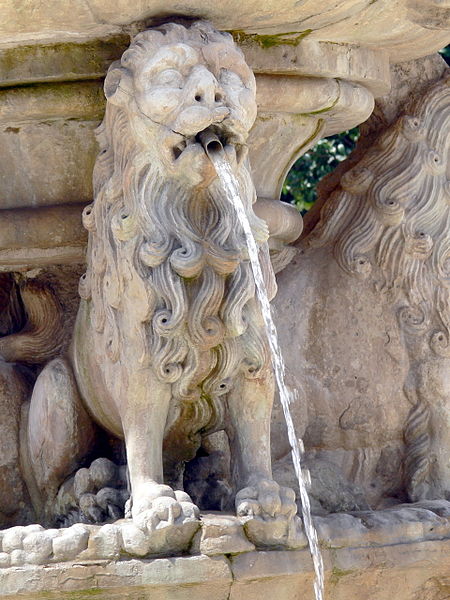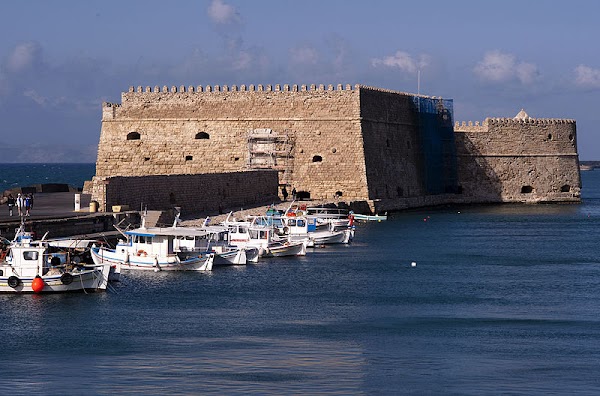Heraklion of Crete Trip Planner
Let's continue our trip to Crete, the largest Greek island.
In Part one of our journey to Crete we were traveling in the region of Chania (Hania), on the western side of the island with its impressive White Mountains (in Greek: Lefka Ori) and its famous National Park. Also we discovered the region of Rethymno, Crete's smallest prefecture located between White Mountains and Mt Psilorítis, which is synonymous with gorgeous mountainscapes, marvellous beaches and Cretan lyre melodies. Today is a time to visit the region of Heraklion, famous because of the archaeological site of Knossos and the capital of Crete.

Heraklion
The largest and most densely populated region on the island of Crete is Heraklion (Iráklion). Nestling picturesquely among two imposing mountain ranges – Ídi (Mt Psiloritis) to the west and Dikti (Lasithiótika mountains) to the east– Iráklion boasts exceptional archaeological treasures, significant coastal settlements, a series of picturesque villages, vast valleys with olive groves and vineyards as well as the best organised tourist infrastructure in Crete. A unique combination of urban scenery and natural wealth makes the region of Iraklion an appealing all-year-round destination.
Crete’s capital, the city of Heraklion presents a unique mixture of civilizations where Byzantine remnants stand side by side with Venetian constructions and Ottoman buildings. The city is also renowned for the medieval fortress of Koules overlooking the Venetian harbour and the Venetian walls that still surround a part of the city. At the southernmost bastion of the fortress, Martinengo Bastion, lies the tomb of Nikos Kazantzakis, the famous Cretan author, whose epitaph reads: “I believe in nothing, I hope for nothing, I am free”.

Morosini Fountain, adorned with four lions, is one of the best known sights in the city. Built by the Venetian governor Francesco Morosini in the 17th century used to supply the fortified city with water. The reconstructed Lóggia across the fountain housed the Venetian headquarters. Today it houses the Town Hall. Admire a plethora of old churches decorating the streets of the city, like Áyios (Agios) Títos (Saint Titos), San Marco Basilica and Ayía Ekateríni. Stroll down the pedestrian streets of the old town with its hive cafés and restaurants and amble around its squares (Lion, Eleftheríou Venizélou and Kornárou squares) to soak up the city’s buzzing atmosphere!

Discover the natural wealth of Heráklion in its stunning gorges (Karterós, Almyrós, Roúvas, Vorisianó, etc.), in the Ecologic-Archaeological Park of Mount Yoúchtas and in a number of caves (most of which are accessible to the public). Explore among others the cave of Ayía Paraskeví, which is said to be part of the Minoan Labyrinth or the cave of Faneroméni. Follow centuries-old footpaths that formed the road network of past times, and explore wonders of nature and the history of the region at the same time.
The most important hiking network of trails is E4, which crosses the region from Mount Psilorítis in the west to Mount Dikti in the east intersecting the most important mountain paths and habitats of the prefecture. Trail E4 from Akólyta to Zarós is quite easy and it takes about 6.5 hours walking. Another splendid trail to Zarós is the one starting from Análipsi springs on Nida plateau, and allows hikers to cross the unique Forest of Roúvas and discover the artificial Lake Vótomos. It is a relatively easy path, about 20km long. An easy 18km trail starts from Áno Arhánes heading to Angaráthou Monastery. In the traditional village of Myrtiá you can find oil and wine presses, while at Astráki you can see the watermills and the springs that supply water to Heráklion.

One of the most beautiful hikes in the south starts from Stérnes, crosses the Arch Passage and ends at Koudoumá Monastery, in a small cove on the coast of the Libyan Sea. Hikers crossing the rough mass of Asteroússia Mountains could even encounter the griffon vulture (Gyps fulvus) of Crete.
A dense network of archaeological sites shows the region’s importance in the past, which was continuously inhabited since the Neolithic Era. Trace centuries of Cretan history and tradition at:
• The archaeological site of Knossos, where one of the most glorious civilizations of humanity, the Minoan civilization, flourished. Situated among olive trees, vineyards and cypresses on the hill of Kefálas, the Palace of Knossos was not only the royal family's residence but also the administrative and religious centre of the whole region. The Throne Room is situated in the west wing. The eastern wing incorporates the royal chambers, the double axes room, the Queen's Suite with the celebrated dolphin fresco, the workshop areas – where the stone carver's workshop holds an eminent position – and the storage rooms.


• In close proximity to Knossos, in the area of Arhánes, you can visit the palace complex at the district where the Turks lived, the cemetery at Fourní, the largest prehistoric cemetery in the Aegean Sea, the Minoan mansion with the famous wine press at Vathýpetros and the Sanctuary of Anemospiliá.
• At Kastélli Pediádos visit the ruins of Lýttos (or Lýctos), one of the most powerful cities of ancient Crete, which was a Spartan colony.
• The archaeological site of Phaestos (Festós), which was the second most important administrative, economic and religious centre in Minoan Crete after Knossos. The Minoan Palace was built around 1900 B.C. and extends over an area of 18,000m2 (the second largest after Knossos Palace).

• In the area of Messará pay a visit at the ancient Górtyna whose regime gained Plato’s admiration. It is not only the archaeological site but also the old churches that attract visitors’ interest.

• Wander among the remains of the Palace of Mália, which resembles the palaces of Knossos and Phaestos. One of the most significant finds is the well-known gold pendant of two bees (which can be seen in the Heráklion Archaeological Museum). The palace was built during the same period as the Knossos and Phaestos palaces and follows the pattern of Minoan palaces, with a west and a central court, storage rooms, workshop areas, ceremonial halls, chambers, holy crypts, etc.
Numerous thematic museums show Crete’s glorious past and modern cultural life:
• Heráklion Archaeological Museum exhibits significant findings of the Minoan Civilisation and is considered to be one of the most important museums of its kind in the world. Thousands excavation finds, from the Disc of Phaestos to the gold pendant of Mália and the clay dancers from Kamilári reveal an ancient-old illustrious past.

• Heráklion Historical Museum presents the evolution of the city during the centuries; among the exhibits stand out three paintings by El Greco and manuscripts of the famous author Nikos Kazantzakis.
• Cretan Ethnology Museum at Vóri reveals the island’s folk life.
• Natural History Museum at Dermatás Bay promotes the unique habitats in Crete and the Mediterranean.
Traditional settlements and historic villages built on mountain slopes and valleys are often surrounded by vineyards and olive groves. Discover the local architecture and spirit of Crete at Arhánes, where neoclassic nobility coexists with rural simplicity, or visit Episkopí with its Byzantine churches. Áno Hersónissos is a picturesque hamlet with Byzantine churches, old wells and stone ovens.
Sun-kissed beaches await the fanatic beachgoers! Enjoy a swim at:
• Amnissós (a beautiful long sandy beach, 7km east of Heráklion),
• Ayía Pelayía, Kalí Liménes (a long sandy beach), the beach of Mália (a crowded resort with thin, white sand, 36km east of Heráklion),
• the beach of Cháni Kokkíni (a wonderful beach with thin, white sand, 13km east of Heráklion known for its north-west winds, which make the place ideal for wind-surfing),
• the beach of Liménas Hersoníssou (a beautiful sandy beach along a small peninsula 27km east of Heráklion, one of the most crowded in Crete),
• the beach of Mátala (a beautiful beach with crystal waters 70km south-west of Heráklion, famous for the caves carved into the rocks, “discovered” by the hippies in the 70's), and
• the beach of Ammoudára (an organised large sandy beach with crystalline waters, 6km west of Heráklion).
Religious celebrations and festivals, traditional popular events, culinary feasts and cultural activities organised throughout the year shape a unique cultural profile. One of the most colourful festivals in Greece, “Heráklion Summer Festival” is held by the Municipality of Heráklion and comprises a rich variety of cultural events. Every summer sea lovers gather in the harbour of Heráklion, where the yacht club of the city organizes yacht races, sailing or rowing lessons and sail rides for the public.

The Wine Festival at Daphnés, organised throughout the first fortnight of July, is dedicated to the local wine of Daphnes and Cretan gastronomy. Sample snails cooked with groats, rabbit with aromatic herbs, pork with celeriac, kaprikó pork grilled with herbs, kalitsoúnia (a pastry filled with cheese) and kserotíyana (honey dipped spiral pastries). Savoury local specialties are complemented with local wine. The region of Heráklion has three VQPRD zones (Vin de Qualité Produit Dans Une Région Déterminée: Wines of Quality Produced in Determined Regions): Pezá, Daphnés and Arhánes, with plenty of wineries and wine museums.

Read Next